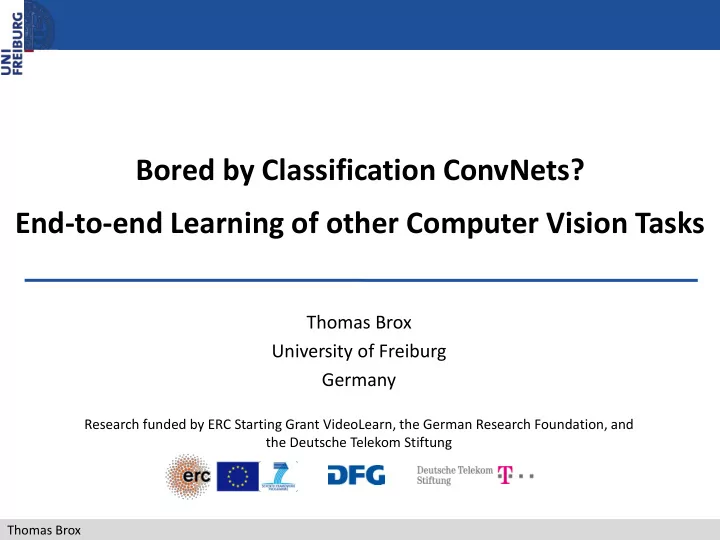

Bored by Classification ConvNets? End-to-end Learning of other Computer Vision Tasks Thomas Brox University of Freiburg Germany Research funded by ERC Starting Grant VideoLearn, the German Research Foundation, and the Deutsche Telekom Stiftung Thomas Brox
Outline Generative networks U-Net: Multi-instance segmentation FlowNet: Estimating optical flow Thomas Brox 2
Typical ConvNet architecture cat Classification network Thomas Brox 3
Typical ConvNet architecture cat cat Classification network Thomas Brox 4
Up-convolutional network Alexey Dosovitskiy CVPR 2015 New: Expanding network architecture Small gray cat office chair, side view Image generation Related work: • Eigen et al. NIPS 2014: Network for depth map prediction • Long et al. CVPR 2015: Network for semantic segmentation Thomas Brox 5
Generating chair images with a network Dosovitskiy et al., CVPR 2015 Thomas Brox 6
Training set 3D chair dataset Aubry et al. CVPR 2014 Rendering 809 chair styles From 62 viewpoints Source: https://github.com/dimatura/seeing3d Some of the rendered chairs Thomas Brox 7
Generating images of unseen views Training set split into two subsets: Source set: 62 viewpoints available (90% of all chair models) Target set: fewer viewpoints available (10% of all models) Thomas Brox 8
Generating images of unseen views 8 azimuths available 4 azimuths available 2 azimuths available 1 azimuth available Thomas Brox 9
Comparison to baselines Alexey Dosovitskiy CVPR 2015 Thomas Brox 10
Interpolation of chair styles Alexey Dosovitskiy CVPR 2015 Thomas Brox 11 11
Correspondences between chair instances Alexey Dosovitskiy CVPR 2015 Thomas Brox 12
Correspondences between chair instances • Generate intermediate images with the network • Track points with optical flow (LDOF) along the sequence all easy difficult Deformable Spatial Pyramid 5.2 3.3 6.3 Matching (Kim et al. 2013) SIFT Flow (Liu et al. 2008) 4.0 2.8 4.8 Ours 3.9 3.9 3.9 Human performance 1.1 1.1 1.1 Thomas Brox 13
Preview: Inverting ConvNets with ConvNets Up-convolutional network Image features e.g. from AlexNet Learn to re-generate the input image from its feature representation Related work: • Mahendran & Vedaldi CVPR 2015 • Zeiler & Fergus ECCV 2014 Alexey Dosovitskiy arXiv 2015 Thomas Brox 14
Reconstruction results Up-Conv. Mahendran & Vedaldi Auto- encoder More reconstructions with up-convolutional network: Thomas Brox 15
Color and position are preserved in high layers Top 5 All but All FC8 FC8 Top 5 FC8 input Color experiment Position experiment Thomas Brox 16
Outline A generative network U-Net: Multi-instance segmentation FlowNet: Estimating optical flow Thomas Brox 17
U-Net: Image segmentation with a ConvNet Olaf Philipp Ronneberger Fischer MICCAI 2015 • Similar to Fully Convolutional Network [Long et al., CVPR 2015] • Original inspiration: Depth map prediction [Eigen et al., NIPS 2014] Thomas Brox 18 18
Binary segmentation Light microscopy cell tracking Electron Microscopy ISBI 2015 Challenge ISBI 2012 Challenge Rank 1 Rank 1 Thomas Brox 19
Multi-class semantic segmentation X-ray dental segmentation, ISBI 2015 Challenge, Rank 1 Intersection over union: 77.5% Second best: 46% Thomas Brox 20
Multi-instance segmentation Light microscopy, DIC-HeLa cell tracking ISBI 2015 Challenge: Rank 1 Thomas Brox 21
Outline A generative network U-Net: Multi-instance segmentation FlowNet: Estimating optical flow Thomas Brox 22
FlowNet: Estimating optical flow with a ConvNet Refinement: expanding architecture Thomas Brox 23
Helping the network with a correlation layer Joint work with the group of Daniel Cremers Philipp Alexey Eddy Philip Vladimir Caner Fischer Dosovitskiy Ilg Häusser Golkov Hazirbas Thomas Brox 24
Enough data to train such a network? • Getting ground truth optical flow for realistic videos is hard • Existing datasets are small: Frames with ground truth Middlebury 8 KITTI 194 Sintel 1041 Needed >10000 Thomas Brox 25
Realism is overrated: the “flying chair” dataset Rendered image Optical flow Thomas Brox 26
It works! Ground truth Input images FlowNetCorr FlowNetSimple Although the network has only seen flying chairs for training, it predicts good optical flow on Sintel Thomas Brox 27
Results on various datasets Middlebury KITTI Sintel Clean Sintel Final Flying Chairs EpicFlow 0.39 3.8 4.1 6.3 2.9 DeepFlow 0.42 5.8 5.4 7.2 3.5 LDOF 0.56 12.4 7.6 9.1 3.5 FlowNetS - - 7.4 8.4 2.7 FlowNetS+v - - 6.5 7.7 2.9 FlowNetS+ft - 9.1 7.0 7.8 3.0 FlowNetS+ft+v 0.47 7.6 6.2 7.2 3.0 FlowNetC - - 7.3 8.8 2.2 FlowNetC+v - - 6.3 8.0 2.6 FlowNetC+ft - - 6.9 8.5 2.3 FlowNetC+ft+v 0.5 - 6.1 7.9 2.7 Networks can compete with state-of-the-art conventional optical flow estimation methods Thomas Brox 28
Can handle large displacements Ground truth Input images FlowNetSimple FlowNetCorr DeepFlow (Weinzaepfel et al. ICCV 2013) EpicFlow (Revaud et al. CVPR 2015) Thomas Brox 29
Sometimes wrong direction Ground truth Input images FlowNetSimple FlowNetCorr DeepFlow (Weinzaepfel et al. ICCV 2013) EpicFlow (Revaud et al. CVPR 2015) Thomas Brox 30
Often captures fine details Ground truth Input images FlowNetSimple FlowNetCorr DeepFlow (Weinzaepfel et al. ICCV 2013) EpicFlow (Revaud et al. CVPR 2015) Thomas Brox 31
Results on “Flying chairs” test set Input images Ground truth FlowNetCorr EpicFlow (Revaud et al. CVPR 2015) Thomas Brox 32
Runs with 10fps on the GPU Thomas Brox 33
Summary A generative network U-Net: Multi-instance segmentation FlowNet: Estimating optical flow Thomas Brox 34
Tip of the day Thomas Brox 35
Recommend
More recommend